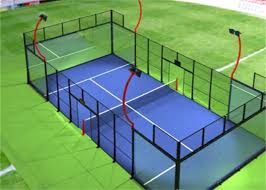

The Rise of Padel Exploring the Padel Ball Court
In recent years, padel has emerged as one of the fastest-growing sports globally, captivating enthusiasts with its unique blend of tennis and squash. Much of this excitement stems from the distinctive concept of the padel ball court, which plays a central role in the game’s appeal. This article delves into the characteristics of a padel ball court, its historical context, and the reasons behind the sport’s rapid popularity.
What is a Padel Ball Court?
A padel ball court is a rectangular surface enclosed by walls, typically measuring 20 meters long and 10 meters wide. Its design is one of its most distinguishing features. Unlike traditional tennis courts, which are open and expansive, padel courts feature glass walls at the back and mesh fencing on the sides. This enclosure allows players to use the walls to bounce the ball, adding an exciting strategic layer to the game. The court is divided into two halves by a net at the center, much like a tennis court, and the playing surface is often constructed from synthetic materials or artificial grass, providing an optimal environment for play.
Historical Context
Padel originated in Mexico in the 1960s and quickly spread to Spain, where it gained immense popularity. The sport was designed to be easy to learn, making it accessible for people of all ages and skill levels. In Spain, the sport has skyrocketed, with countless padel ball courts being built throughout the country. The game has also gained traction in various other countries, with new courts appearing in Europe, Latin America, and beyond. This global expansion is partly due to its appeal as a social activity, as players often enjoy a friendly atmosphere during matches.

Why is Padel So Popular?
One of the key reasons for padel's surging popularity is its accessibility. Unlike tennis, which often requires a high degree of skill and experience, padel is easier for beginners to pick up. The smaller court size and the inclusion of walls allow for longer rallies and more dynamic gameplay. This makes it an excellent choice for casual players looking to enjoy a fun workout without the steep learning curve.
Additionally, padel is typically played in doubles, fostering a sense of camaraderie among teammates. The social aspect transforms a simple game into a shared experience, often leading to a vibrant community of players. Facilities that host padel ball courts often include amenities such as lounges, bars, and restaurants, further enhancing the social environment.
The rise of padel has also been bolstered by the increasing visibility of professional tournaments, which attract both local and international audiences. The sport's professionals showcase thrilling matches, helping to elevate its status and inspire new players. As more people become aware of padel and its lively atmosphere, interest continues to grow exponentially.
Conclusion
The padel ball court symbolizes both the sport's cultural significance and its burgeoning popularity. Its unique design, combined with the accessible nature of padel, has made it a favorite among sports enthusiasts worldwide. As padel continues to expand, it is poised to make an indelible mark on the global sports landscape, inviting players of all backgrounds to join in on the fun. Whether played casually among friends or competitively in tournaments, padel promises a dynamic and engaging experience for everyone involved.
High-Performance Industrial Flooring Solutions China Paddle Tennis Court for Sale
High-Performance Industrial Flooring Solutions Durable & Cost-Effective
Homogeneous Transparent Floor – Durable & Stylish Rubber Floor Solutions
Premium Homogeneous Transparent Floor for Durable & Stylish Spaces Rubber Floor Solutions
Premium Sports Floor Solutions Durable PVC Sports Floor & Rubber Floor for Gyms
Durable Rubber Composite Floor Premium Rubber Floor & Mats Solutions